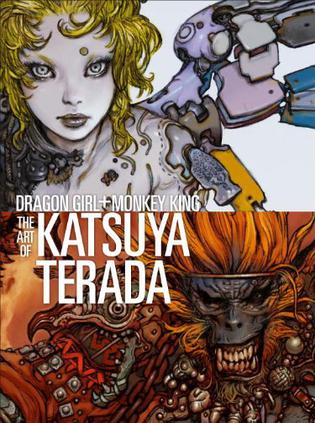
Dark fantasy is his wheel-house, but hard-boiled SF is also indebted to his unstained brushes and pens, his freely applied and completely illusory oils, his roughly layered tones of ones and zeroes he is a true innovator, and was integral to the way digital painting has evolved. His work is populated by demons and corrupted angels, wizards and hybrid monsters, astronauts and intricately rendered spacecraft. The 'Dragon Girl' is a reference to one of his more recent paintings… …representing his long and prolific career in illustration. Terada is one of the few who does great work with zero pretention, in a genre too easily dismissed: Terada firma – I’m not a huge fan of SF and fantasy illustration, but that’s because so much of it is awful. Or it freaks out people with pre-fried brains. Still, there will be unholstered nipples, and for some reason that’s still something that fries people’s brains. But Terada is far more than a pin-up artist, and even the small percentage of his output that might qualify as pin-up art is fucking incredible.


Not because it's politically incorrect or wrong, I just find it repetitive, dull, and tacky. A warning: Terada’s also famous for his improbably gorgeous women, erotic art that combines some fucked-up and light-hearted SF/fantasy themes. Now though, we have this excellent oversized hardcover from Dark Horse, and being an artbook, it’s best read as an artbook too. Without those Buddhist ‘hooks’, 'The Monkey King' is a visually stunning but thoroughly confusing comic… and best read as an artbook.

Even as an Agnostic who turned his back on fundamentalist dogma as a teen, remnants of that faith still have their hooks in me. It's not a great read, at least for those of us without the same species of intimate connection to the sacred Buddhist text I think it requires a relationship to the material similar to the one Christians and ex-Christians have with the Bible. Terada's full-color manga adaptation of the Buddhist classic 'Journey to the West' is the 'Monkey King' referred to in the title, a visually spectacular epic that radically re-imagined it's source material, with a sexually-charged irreverence typical of his career. Yoshitaka Amano and Katsuhiro Otomo are likely his equals in terms of influence - Amano as an illustrator, and Otomo as the mangaka who reordered the sequential art universe with Domu and Akira - but Terada was one of the true pioneers of digital painting perhaps the first artist to create art from ones and zeroes that still felt organic and expressive. Katsuya Terada doesn't have many rivals in the world of Japanese illustration and manga. Terada Firma: Dark Horse Deliver the First Significant Art-book on Katsuya Terada for North American Markets


 0 kommentar(er)
0 kommentar(er)
